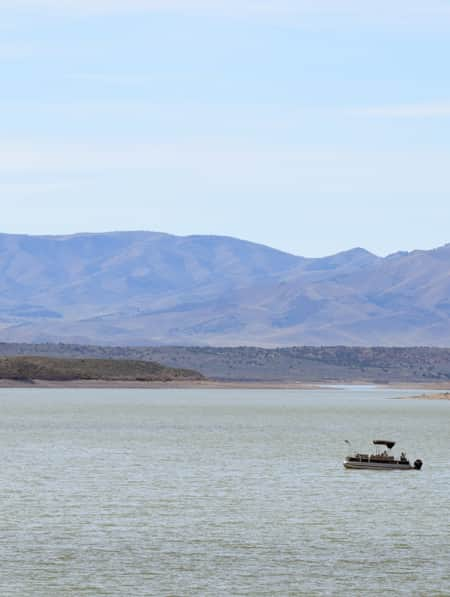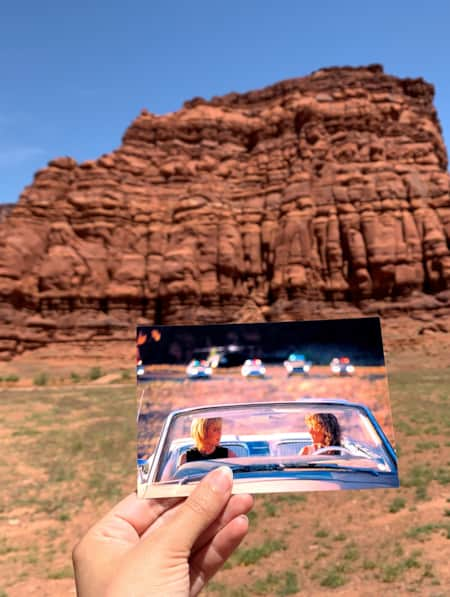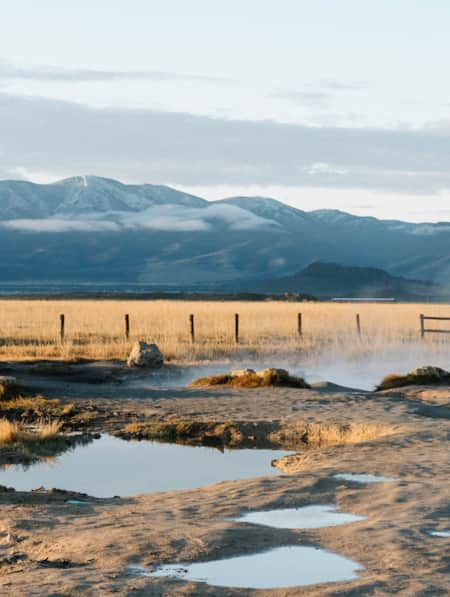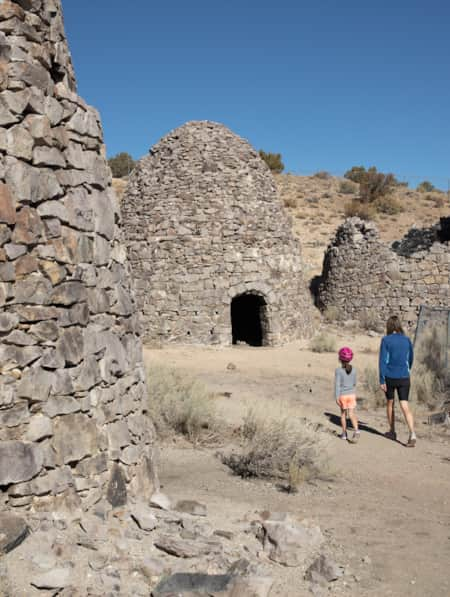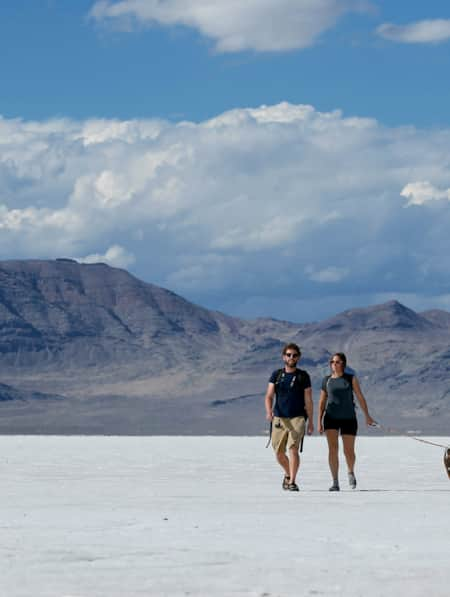The Spiral Jetty, Utah’s Most Iconic Land Art Sculpture, Keeps Drawing a Crowd
How one small piece of land art about entropy made history.

One day in the spring of 1970, Robert Smithson plunked down $100 to lease 10 desolate acres of brine and rocks. His plan, he wrote on his application to the Utah Division of State Lands, was to “induce salt crystals on the rock and gravel as incrustations that will develop over a period of time.” Its purpose,” he added, “is purely aesthetic.”
In certain circles, as far away as Italy, Smithson was already a celebrated artist. On that spring day in Utah, he was just some guy from New Jersey with a crazy idea about making something — a spiral, did he say? — out at the Great Salt Lake. It’s easy to imagine the clerks rolling their eyes. I like to imagine Smithson beaming as he drives north on I-15 towards Rozel Point.
What he imagined was a curving line of rocks and earth that would lead from the shoreline of the lake into the water. It would be a sculpture, but one that didn’t need a museum or even an audience. And might just as easily fall apart as last forever. It would be a monument to impermanence, if he were the kind of man who believed in monuments. He was, as he often said, a fan of entropy.
It took six days, 625 man-hours, 292 truck-hours, $9,000, and 6,500 tons of basalt, limestone and mud to construct the sculpture that April. It took only a few years after that for stunning aerial photos to show up in art history textbooks, which heralded Smithsons’s spiral as an icon of the new land art movement.
But by then, sure enough, a universe hell-bent on entropy had taken its toll. Smithson died in a plane crash in 1973, at age 35, while he was surveying another land art site in Texas. Meanwhile, along the Wasatch Front, the weather got wetter and the Great Salt Lake flooded the spiral, submerging it for the next two decades. Most everyone in Utah ignored the jetty, if they knew about it at all.
Then, around the turn of the millennium, the lake began to steadily get lower and smaller — and the beguiling spiral was consistently visible and available again. There were articles in “The New York Times,” and, later, there were YouTube videos. Now people from all over the world wanted to come walk its twisty path.
Now the Spiral Jetty is a middle-aged work of art that has endured after all.

Artist Robert Smithson's Spiral Jetty.
Photo: Sandra Salvas
"It took six days, 625 man-hours, 292 truck-hours, $9,000, and 6,500 tons of basalt, limestone and mud to construct the sculpture that April."
These days, the Spiral Jetty is still a spiral but not much of a jetty. The black rocks of the path lead you westward across the dry playa, eventually into a smaller and then smaller circle, but when you are down among the rocks you lose sight of the pattern. To really see the sculpture you need to stand on the hill above it. Even then, if you are a lover of the iconic photos, you may be expecting something bigger and more dramatic.
To visit Spiral Jetty is a decision and a detour: An hour heading west from a freeway, on a gravel road, then dirt, flanked sometimes by cattle, out on the open range, definitely out of cell range, until, finally, there’s the lake in the distance. And then you’ll see the quirky earthwork itself, looking a little forlorn and marooned down below. (Visitors should be mindful that low water levels at the Great Salt Lake have increased the natural presence of tar around the Spiral Jetty shoreline. Watch your step and keep dogs on leash.)
Truthfully, the Great Salt Lake isn’t my go-to landscape. What I like are lakes surrounded by trees, green hills dotted with daisies, bonus points for a little white farmhouse off in the distance. The Great Salt Lake at Rozel Point — stark, still and muted on a partly cloudy spring morning — is nothing like that. It feels like a desert masquerading as a body of water.
It is, in fact, an analog for Mars, which is why NASA is partnering with the Great Salt Lake Institute, housed at Westminster College, to take an infrared look at the lake’s salt and gypsum. The hope is that the existence of salt and gypsum on Mars — which once also had water — might mean there are salt-loving microbes still tucked inside the crystals there.
Bonnie Baxter and Jaimi Butler, co-founders of the Institute, like to call themselves Salty Sirens, because they aim to lure people to take a closer look at the threatened briny expanse that Utah’s capital city is named after. Changes in water usage (basic formula: more people plus more watered lawns equals more water diverted from the northern Utah rivers that empty into the lake) plus climate change adds up to a stark fact. “Great Salt Lake has little hope of recovery,” write Butler and Baxter in an essay posted on the website of the Utah Museum of Fine Arts in honor of Spiral Jetty’s 50th anniversary. (Read: Great Salt Lake Needs Your Visit)
"The Spiral Jetty is a middle-aged work of art that has endured after all."
One victim of the shrinking water: the pelicans that live on Gunnison Island across the lake. “The pelicans’ demise,” they write, “is obvious at the site of the artwork, where you may find carcasses of baby pelicans that cannot fly far enough to catch food for themselves.”
The site where there is now a lake has a long history of ups and downs spanning 800,000 years. More recently — 30-something thousand years ago — the body of water explorers called Lake Bonneville started as a freshwater pond that spread across what’s now western Utah and into parts of Nevada and Idaho. When the lake began to shrink, it did so in stages, which you can witness as layers along the foothills of the Wasatch Mountains and, at a lower elevation, layers along the Promontory Mountains in Box Elder County.
Robert Smithson was drawn to Box Elder’s Rozel Point because of its connection to deep time, as well as to the detritus of more recent oil exploration nearby. “This site gave evidence of a succession of man-made systems mired in abandoned hopes,” he applauded in a 1972 essay.
He was also drawn to the color of the water in the north arm of the lake. Separated from the bigger, southern arm by a causeway, the north arm is saltier — 10 times saltier than the ocean these days — which means not much can live there except brine shrimp, brine flies and some feisty microbes that love salt the way someone might be happy to survive on bacon. These bacteria, archaea and algae contain carotenoids that protect them from ultraviolet light and thus provide the lake’s reddish tint. “The water is red, like an entropic landscape,” Smithson wrote. He described it as the color of wine, or sometimes “so bloody a hue as to bring to mind a geography of unspeakable carnage.”
Jaimi Butler, who has young children, describes the color more in terms of “Barney purple” and “strawberry lemonade pink.” Sometimes, though, you have to squint at the horizon to see any color at all. The color, the smell, the lake itself, can change by the hour, so if you go out there you don’t know what you’ll get. As Hikmet Loe, who teaches at University of Nevada, Las Vegas, writes in her sweeping study “The Spiral Jetty Encloclo,” the lake has a “strange and incessant capacity to reinvent itself.”

Spiral Jetty, 1970.
Photo: Photo provided by Dia Art Foundation and Nancy Holt.
"Robert Smithson was drawn to Box Elder’s Rozel Point because of its connection to deep time, as well as to the detritus of more recent oil exploration nearby."

The Spiral Jetty invites close study of the mineralized colors at play.
At first, Smithson wanted more of a j-shaped jetty, with a small island in the center, but when he stood on the hill and looked down on the sculpture he was disappointed. So he paid foreman Bob Phillips and his crew another $3,000 to take away the “j” and make a counterclockwise, true spiral instead.
Here’s some psychedelic prose from Smithson after viewing the jetty from a helicopter: “I was slipping out of myself again, dissolving into a unicellular beginning, trying to locate the nucleus at the end of the spiral.”
Smithson had a disdain for the picturesque, the pastoral, and the commercial, questioning even the very purpose of art as something to be viewed. He hated what he saw as artists’ “servitude” to “the vile laws of Culture.”
At Kent State University a few months before arriving in Utah, he created “Partially Buried Woodshed,” which is just what it sounds like. On several occasions he brought rocks into galleries, put them in nicely crafted bins, and called it a Non-Site. “He was always asking these questions of us,” said gallery owner Virginia Dwan, who supported Smithson’s work: “What is the work of art? Is it the metal container, the rocks, the location it came from?”
In Vancouver, British Columbia, he created “Glue Pour,” in which a lot of glue was poured down a hillside. Outside Rome, he created “Asphalt Rundown,” in which a dump truck unloaded its contents, also down a hillside. You can watch both of these on YouTube in a grainy film that includes a voice-over by his wife, artist Nancy Holt, explaining that the work is “entropy made visible.” Holt is best known for her own Utah land art, the Sun Tunnels on the western side of Great Salt Lake, which were completed in 1976.
What would Smithson think now of his Spiral Jetty, and of the world it resides in? A pandemic fits nicely with his acceptance of things falling apart, but he might not have predicted how popular the jetty would become as an outlet for social distancing.
Would Smithson, the lover of imperfection, have approved of a clean-up of the area that removed rusted rigs and trailers, and smoothed out the dirt road? Would he have approved of the successful efforts in 2008 to prevent oil drilling nearby? Would he want anyone to shore up the jetty as weather and time take their toll? These are questions that the stewards of the site — the Dia Art Foundation in New York City, the Great Salt Lake Institute, and the Utah Museum of Fine Arts — ponder.
What would Smithson have thought about the families who arrive these days and set up lawn chairs between the jetty and the edge of the receding lake? What would he make of the people wading with their pants rolled up, the couple with a giant beach towel, the voices traveling lazily and clearly across the water, a little girl shouting “Hey guys, look what I found!”
The morning I visited the jetty in mid-May, I found a heart carved into the exposed, dry lakebed. “H + M 4ever,” it read, probably not referring to the clothing store but to somebody who loved somebody else. In the face of entropy, we all like to make our mark. We like to think about 4ever.
Although already somebody had walked across the "H."
Property law, which likes to know who owns what, has a lovely term for the shifting edge of a lake’s shore: the meander line. Or, as Smithson preferred, “the meandering zone,” a phrase that conjures up a place where he might casually stroll as he pondered art, the universe and everything. A place where he could walk happily in a circle, counterclockwise against the direction of time, even when he knew that time only marches forward.
Everything out here is microscopic and cosmic at the same time. I am standing in the middle of a circumference that stretches nearly around me, revealing the uncomfortable truth that I’m standing on the surface of a round planet suspended in space. It’s disorienting and unnerving, but also liberating, the way it might be to think of art not as a landscape painting but as asphalt sliding down a hill.
Artists, Smithson said, “must come out of the isolation of galleries and museums and provide a concrete consciousness for the present as it really exists, and not simply present abstractions or utopias.”
At the edge of the water, I think of Billy Collins’s poem “Aimless Love.” “This morning,” it begins, “as I walked along the lakeshore / I fell in love with a wren / and later in the day with a mouse / the cat had dropped under the dining room table.”
He’s talking about a different lake, but the idea is the same. It’s possible to fall in love with this very moment, even a disconcerting one — the moment in which a woman is content to pick her way across basalt and sand, surrounding by a lake that looks nothing like what she imagined it should, in a life that is never as certain as we wish.






